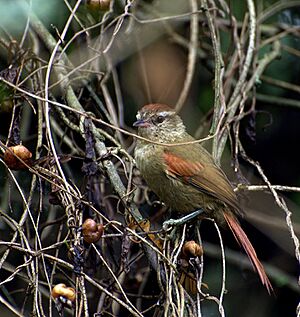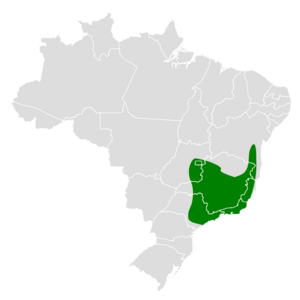Pallid spinetail facts for kids
Quick facts for kids Pallid spinetail |
|
|---|---|
 |
|
| Conservation status | |
| Scientific classification | |
| Genus: |
Cranioleuca
|
| Species: |
pallida
|
 |
|
The pallid spinetail (Cranioleuca pallida) is a small bird that belongs to the ovenbird family called Furnariidae. It is found only in Brazil. This bird gets its name "spinetail" because its tail feathers look a bit spiky at the ends.
Contents
About the Pallid Spinetail
What's in a Name?
The pallid spinetail is a unique bird. It is considered monotypic, which means it is the only species in its group. It is closely related to two other spinetail birds: the stripe-crowned spinetail and the olive spinetail.
How to Spot a Pallid Spinetail
The pallid spinetail is a small bird, about 14 to 15 centimeters (5.5 to 5.9 inches) long. It weighs around 11 to 12 grams (0.39 to 0.42 ounces). Both male and female birds look the same.
They have a wide, whitish stripe above their eye, like an eyebrow. There's a small black spot in front of their eye and a dark brown band behind it. Their cheeks are buffy (a pale yellowish-brown) with faint dark streaks.
The top of their head is a dark reddish-brown, and their neck is gray. Their back is a mix of tawny-olive or olive-brown colors. Their tail is dark reddish-brown and looks spiky because the feathers don't have full feathery parts at the tips.
Their wings have reddish-brown feathers, and their flight feathers are pale cinnamon or olive-brown. Their chin is whitish, and their throat and chest are a bright buffy or brownish-olive. Their belly is a duller pale brownish-olive.
Their eyes can be reddish-brown or pale brown. Their upper beak is black, and their lower beak is pinkish with a dark tip. Their legs and feet are greenish-olive or gray. Young birds look similar but have a darker back and a brown head.
Where They Live
The pallid spinetail lives in southeastern Brazil. You can find them in states like southern Goiás, central Minas Gerais, southeastern Bahia, and eastern Paraná.
They prefer to live in mountain evergreen forests, woodlands, and older secondary forests (forests that have grown back after being cut down). They live at elevations from about 700 to 2,150 meters (2,300 to 7,050 feet) high.
Pallid Spinetail Behavior
Daily Movements
The pallid spinetail stays in the same area all year round. It does not migrate to other places.
What They Eat
These birds mostly eat arthropods, which are small creatures like insects and spiders. They usually hunt for food in pairs. Often, they join mixed-species feeding flocks, which are groups of different bird species feeding together.
They are very agile, meaning they move quickly and easily. They pick their prey from vines, dead leaves, tree bark, and even from flowers and fruits. They climb along small branches from the middle to the top parts of the forest trees.
Reproduction and Life Cycle
Scientists believe that pallid spinetails are monogamous, meaning a male and female bird stay together to raise their young. They are thought to breed during the spring and summer in the Southern Hemisphere.
Their nest is shaped like a globe and is made of lichen and moss. It has an entrance on the side. They usually build their nests on a tree branch, close to the trunk, or on top of a clump of epiphytes (plants that grow on other plants). We don't know how many eggs they lay, how long the eggs take to hatch, or how long it takes for the young birds to leave the nest.
Their Calls and Songs
The pallid spinetail has a unique song. It's a very high-pitched series of about five notes that go down slightly, often speeding up into a trill at the end. Their call sounds like "tééé-ssik, tséé-ssik".
Status and Conservation
The IUCN (International Union for Conservation of Nature) has listed the pallid spinetail as a species of "Least Concern." This means that, for now, it is not considered to be in immediate danger of extinction.
It lives across a large area, but we don't know exactly how many of these birds there are. However, their numbers are thought to be decreasing. One big problem is that a lot of their forest home has been cut down. Even though they live in some protected areas, losing their habitat is a serious concern for their future.


